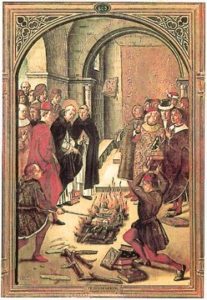What is the scariest book you’ve ever read?
-Stephen King’s fans swear it’s “Pet Sematary” or “The Shining,”
-Perhaps you read “Psycho,” the novel (later made into the epic Hitchcock film),
-“The Raven” may still give you goose bumps and,
-I challenge you to read Bram Stoker’s 1897 “Dracula,” and then turn out the lights.
Despite these noteworthy chillers, “Fahrenheit 451,” written by sci-fi master Ray Bradbury, is at the top of my list of haunting books. You won’t find any typical ghouls, but instead, human beings who precariously teeter in the grips of a culture gone mad.
In this eerie place, overdoses, driven by despair, are epidemic. Medics hustle from home-to-home and nonchalantly pump stomachs and detoxify blood of the afflicted―treating their symptoms, but not the disease.
Home entertainment screens are ensconced on two, three, and sometimes all four walls, where zombie-like viewers read tidbits from canned scripts that make them feel that they are truly a part of the show. (Perhaps Bradbury had a prescient vision of modern reality-TV?)
 Most creepy are the firemen whose jobs are to set books, and the houses that harbor them, ablaze. In this bizarro-world, books are not only not sacred and not revered, but they are banned, outlawed, and burned. The penalty for owning them is death.
Most creepy are the firemen whose jobs are to set books, and the houses that harbor them, ablaze. In this bizarro-world, books are not only not sacred and not revered, but they are banned, outlawed, and burned. The penalty for owning them is death.
I’ll avoid any spoilers, but if you missed this Orwellian-like classic, put it on your reading list and if you have already read it, put it on your list to revisit.
Bradbury wrote “Fahrenheit 451” during the McCarthy era, when books and the ideas they contained were often under siege. It harkens a week that we acknowledge each September: Banned Books Week. Ironically, “Fahrenheit 451” was among the top 100 banned/challenged books between 2000 and 2009 according to the website for the Intellectual Freedom of the American Library Association.
Books that are among the most often banned are far from the most vapid, violent, or lascivious of the best sellers, but instead often run against the grain of bigotry and hypocrisy and they challenge mainstream comfort. Between 1990 and 1999, “The Adventures of Huckleberry Finn” was still the fifth most requested banned book. Just last year, legislators in Randolph County North Carolina elected to ban Ralph Ellison’s “Invisible Man” from school libraries, but then reversed that decision amidst popular protest.
“Fahrenheit 451” contains a passage that explains why books are sometimes hated and feared: “They show the pores in the face of life.”
The idea that there are still banned books in our country renowned for freedom seems surreal to me―almost like there would be witches on trial in Salem. Speaking of which, add Arthur Miller’s “The Crucible” to your list of scary screenplays.

 Although it might seem like hyperbole, there’s the proverbial slippery slope between a philosophy that supports banning books and one that supports burning them―among the things that tyrants do to remove opposing views. Nazi Germany championed this extreme censorship, stoking the flames of extremist views, and then heaping “un-German” books into real bonfires.
Although it might seem like hyperbole, there’s the proverbial slippery slope between a philosophy that supports banning books and one that supports burning them―among the things that tyrants do to remove opposing views. Nazi Germany championed this extreme censorship, stoking the flames of extremist views, and then heaping “un-German” books into real bonfires.
In “The Favoured Daughter,” author Fawzia Koofi described the horror when the Taliban captured control in Afghanistan, looted museums, and destroyed priceless artifacts dating from the era of Alexander-the-Great. She wrote, “Then they started destroying our minds. They burned the schools and university buildings. They burned books and banned literature.”
As John Stuart Mill wrote in “On Liberty”, “If all mankind minus one, were of one opinion, and only one person were of the contrary opinion, mankind would be no more justified in silencing that one person, than he, if he had the power, would be justified in silencing mankind.”
What is the scariest book you’ve never read?
One that is banned, of course.